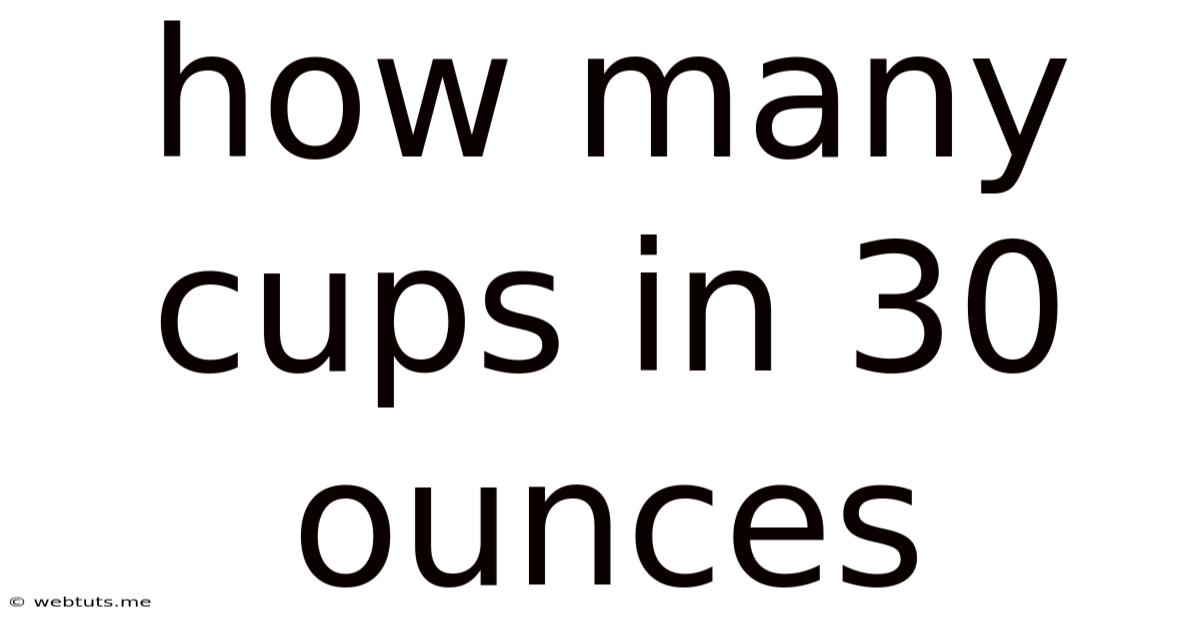How Many Cups In 30 Ounces
Webtuts
May 12, 2025 · 4 min read

Table of Contents
How Many Cups in 30 Ounces? A Comprehensive Guide to Fluid Measurement
Converting between ounces and cups is a common culinary task, and the question "How many cups are in 30 ounces?" arises frequently. This comprehensive guide will not only answer that question definitively but also explore the nuances of fluid measurement, provide helpful conversion tips, and delve into practical applications across various cooking and baking scenarios.
Understanding the Ounce and Cup Measurements
Before we delve into the conversion, let's establish a clear understanding of the units involved. Both ounces (oz) and cups (c) are units of volume, commonly used in the United States for measuring liquids and sometimes dry ingredients. However, it's crucial to remember the context: we are focusing on fluid ounces, not weight ounces.
-
Fluid Ounce (fl oz): A fluid ounce is a unit of volume, representing approximately 29.57 milliliters (ml). It's important to note that the fluid ounce is distinct from the avoirdupois ounce, which is a unit of weight.
-
Cup (c): A US cup is typically defined as 8 fluid ounces (fl oz). This is the standard used in most American recipes and cookbooks. Other countries may use different cup sizes, so always refer to the recipe's specified measurements.
Calculating Cups from Ounces: The Simple Conversion
The basic conversion is straightforward: there are 8 fluid ounces in 1 cup. Therefore, to find out how many cups are in 30 ounces, we simply divide the number of ounces by the number of ounces per cup:
30 fl oz / 8 fl oz/c = 3.75 cups
Therefore, there are 3.75 cups in 30 ounces.
Practical Applications and Recipe Considerations
Understanding this conversion is crucial for various kitchen tasks:
Baking: Precision is Key
In baking, accuracy is paramount. Using a measuring cup to measure 3.75 cups accurately can be tricky. In such cases, it's best to understand fractional measurements and use the appropriate measuring tools. For 3.75 cups, you would use:
- 3 cups: Easily measured using a standard measuring cup.
- ¾ cup: This can be measured using a smaller measuring cup or by filling a larger cup to the ¾ mark.
Having a set of measuring cups (e.g., 1/4 cup, 1/3 cup, 1/2 cup, 1 cup) is essential for precise baking.
Cooking: Flexibility and Estimation
Cooking allows for slightly more flexibility than baking. While precise measurements are still important, a slight variation in liquid amount often doesn't dramatically affect the outcome. For 3.75 cups in a cooking scenario, you could reasonably round to either 3 ¾ cups or even 4 cups depending on the recipe and your preference.
Other Applications: Beyond the Kitchen
This conversion isn't limited to the kitchen. It can be applied in numerous situations, from determining the volume of liquids in various containers to calculating the amount of liquid needed for cleaning solutions or other household projects.
Advanced Considerations: Variations and Potential Issues
While the basic conversion is simple, there are subtle factors to consider:
-
Variations in Cup Sizes: While the standard US cup is 8 fluid ounces, some recipes might use slightly different cup measurements. Always double-check the recipe's instructions for clarification. International recipes may use metric units, requiring further conversion.
-
Liquid Density: The density of liquids varies. Water is the standard, but denser liquids like oil or honey will occupy the same volume but weigh more. This distinction isn't crucial for most cooking applications, but it is important to keep in mind for scientific or industrial purposes.
-
Measuring Techniques: The way you measure liquids affects accuracy. Ensure you're using the correct measuring tool and technique for reliable results. Avoid overfilling or underfilling the measuring cup. Look at the measurement at eye level for the most accurate reading.
Troubleshooting Common Measurement Mistakes
Here are some common mistakes to avoid:
-
Confusing Fluid Ounces and Weight Ounces: This is a frequent error. Remember, fluid ounces measure volume, while weight ounces measure weight.
-
Using Inconsistent Measurement Tools: Mixing and matching various measuring tools can lead to inaccuracies. Stick to a consistent set of measuring cups and spoons for best results.
-
Not Leveling Off Dry Ingredients: When measuring dry ingredients, use a straight edge to level off the top of the measuring cup. A slightly overflowing cup can significantly alter the final product.
Beyond 30 Ounces: Expanding Your Conversion Skills
The principle of dividing ounces by 8 to get cups can be applied to any ounce measurement. Need to convert 15 ounces to cups? 15 oz / 8 oz/c = 1.875 cups (or 1 and 7/8 cups). The same principle applies to converting any number of ounces into cups.
Conclusion: Mastering Fluid Measurement for Culinary Success
Mastering fluid measurement is essential for any successful cook or baker. The conversion from ounces to cups, while seemingly simple, requires attention to detail and a clear understanding of the units involved. Remember the fundamental conversion factor of 8 fluid ounces per cup, and always use accurate measuring techniques for consistent and delicious results. By understanding the nuances of measurement and avoiding common mistakes, you can confidently tackle any recipe and achieve culinary perfection. Understanding how many cups are in 30 ounces—and, more importantly, how to handle similar conversions—is a foundational skill for anyone who enjoys cooking or baking.
Latest Posts
Related Post
Thank you for visiting our website which covers about How Many Cups In 30 Ounces . We hope the information provided has been useful to you. Feel free to contact us if you have any questions or need further assistance. See you next time and don't miss to bookmark.